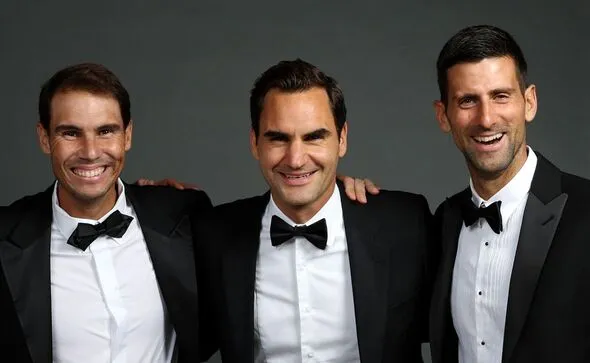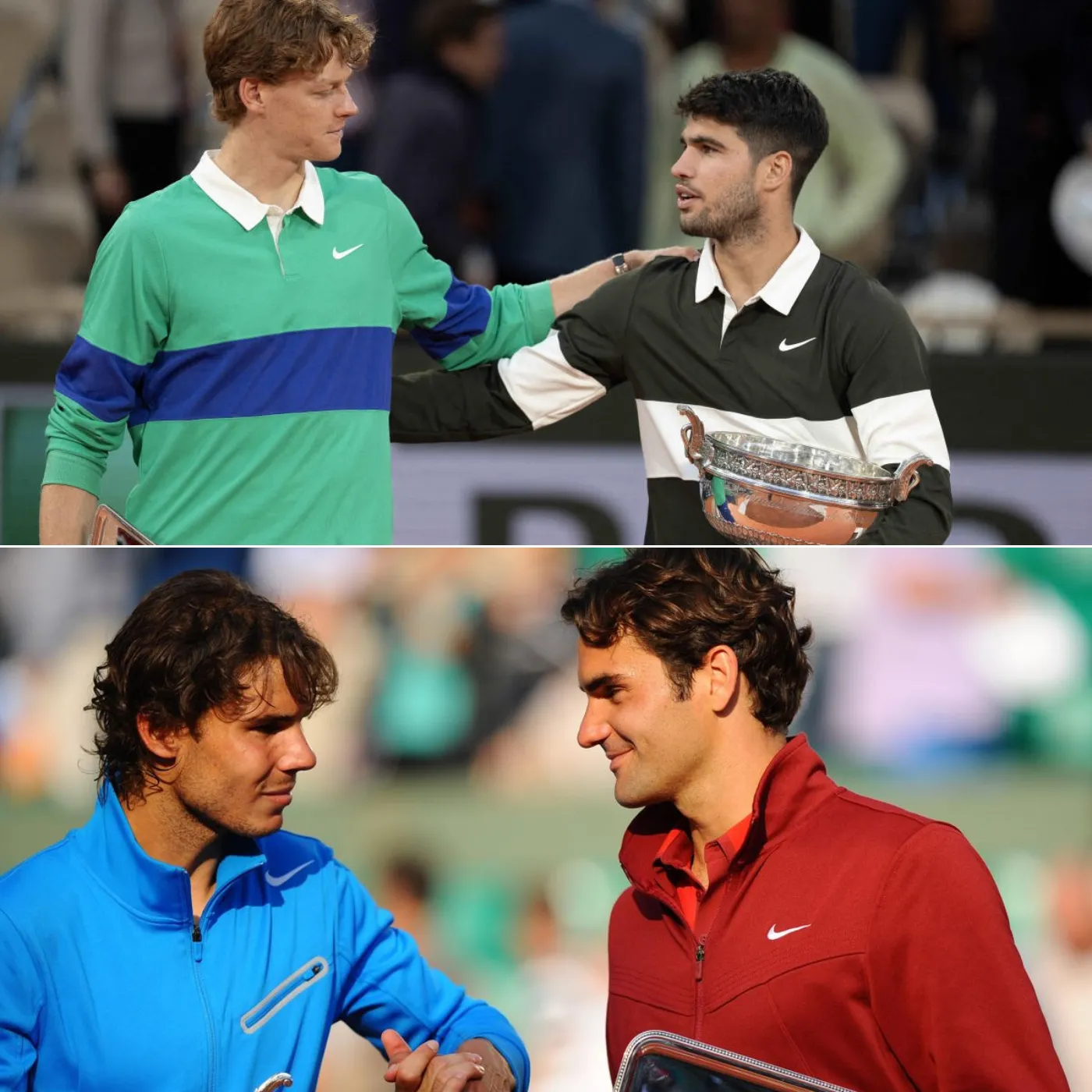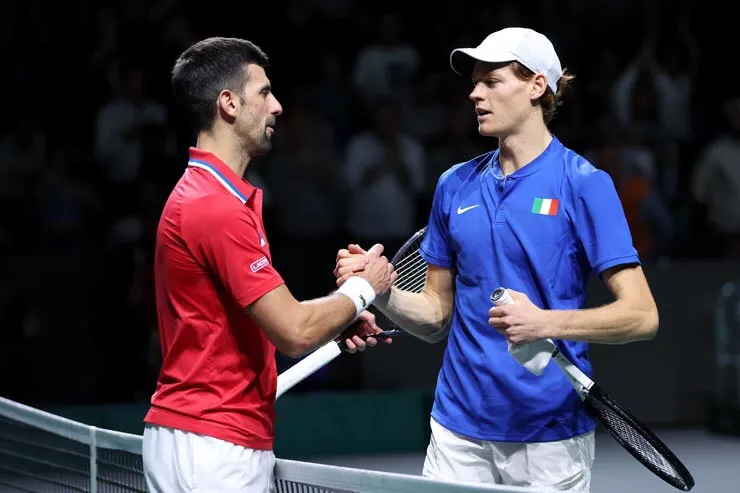

Is the Big 3 Era Officially Over? Alcaraz and Sinner Just Changed the Game Forever
For nearly two decades, men’s tennis has revolved around an iconic trio: Roger Federer, Rafael Nadal, and Novak Djokovic — the Big 3. Their reign over the sport has been not only statistically dominant but culturally transformative. They’ve amassed a staggering number of Grand Slam titles, shattered records, and built fanbases that span continents. But in 2024 and 2025, a dramatic shift has unfolded, signaling what might be the true end of that golden era. While Carlos Alcaraz has already made headlines as a generational prodigy, it is Jannik Sinner, the calm and cold Italian precisionist, who has truly cemented the transition from the old guard to a new age.

Jannik Sinner: The Iceman Who Shattered the Silence
For years, Jannik Sinner was often spoken about in terms of potential — a rising star with textbook technique, admirable composure, and a tireless work ethic. But in early 2024, something changed. No longer just “promising,” Sinner became a Grand Slam champion, claiming the Australian Open in dominant fashion. And he didn’t stop there. He followed it up with consistent deep runs, victories over top-ranked players, and a newly acquired ATP World No. 1 ranking, dethroning legends and newcomers alike.
What sets Sinner apart is not only his cool temperament but also his complete transformation in style and confidence. Early in his career, some critics questioned whether he had the mental steel to win at the highest level. He has answered them all — not through words, but through unrelenting action, baseline mastery, and an uncanny ability to adapt mid-match.
In 2025, Sinner is no longer the future — he is the present, and arguably, the new face of men’s tennis.
The Fall of the Big 3: A Long Goodbye
The Big 3 did not fall overnight. Federer officially retired in 2022, leaving behind a legacy of elegance and artistry. Nadal, battling physical limitations, has hinted at retirement more than once and now struggles to make deep runs. Djokovic, the last remaining titan, remains a formidable competitor, but even he cannot defy time forever. Losses to Sinner, Alcaraz, and other next-gen stars have grown more frequent. And perhaps more importantly, those losses are no longer considered upsets — they’re expected.
The emotional weight of watching Djokovic fall in the semifinals to Sinner at the ATP Finals, or seeing Alcaraz overwhelm him with sheer athleticism at Wimbledon, speaks volumes. It’s not just that the legends are aging — it’s that the new generation has evolved to surpass them. Tennis has a new pace, a new physical demand, and a fresh strategic complexity. The old playbook doesn’t work anymore.
Alcaraz vs. Sinner: The Rivalry That Redefines Everything
While Carlos Alcaraz brings unmatched explosiveness, charisma, and an attacking mindset reminiscent of a young Nadal, Sinner represents the modern ice-cold technician: consistent, precise, and resilient. Their head-to-head battles are not only thrilling but symbolic — a perfect metaphor for the new age of tennis.
Their matches, whether on the hard courts of Miami or the grass of Wimbledon, have featured incredible shot-making, mental fortitude, and dramatic swings in momentum. One could argue that their rivalry is already producing matches that rival any classic Federer–Nadal showdown. But what’s even more compelling is that these aren’t isolated events — they are the new normal.
In 2025, every tournament feels like it is orbiting around Alcaraz and Sinner. They are the gravitational centers of the ATP Tour. And unlike the early 2000s, when dominance was achieved through grinding attrition, these two are redefining what peak performance looks like — it’s faster, smarter, and far more dynamic.
Sinner’s Tactical Evolution: The Blueprint for Modern Tennis
Unlike many young players who rely heavily on raw athleticism, Jannik Sinner has taken a far more cerebral approach to his rise. Under the guidance of coach Darren Cahill, he’s refined not just his physical tools but his mind. Every stroke now has purpose. His backhand is a laser — arguably one of the most lethal two-handers on tour. His serve, once a weakness, is now a weapon. And most importantly, his movement and court coverage have improved exponentially.
This is what truly separates him from his peers: Sinner is a tactician. He doesn’t just play the match — he solves it. Like a grandmaster in chess, he adjusts his strategy in real time, exploits weaknesses, and minimizes risk. Against powerful servers, he shortens points. Against baseliners, he outlasts them in rallies. This versatility has become his trademark and a warning to the rest of the field: you cannot beat Jannik Sinner with Plan A — or Plan B.
Mentally Unshakeable: The Silent Power of Composure
In the emotionally charged world of tennis, where crowd pressure, opponent mind games, and personal demons often derail even the most talented athletes, Sinner is almost machine-like in his resolve. Unlike Alcaraz, who wears his passion on his sleeve, or Djokovic, who often feeds off external emotion, Sinner is an island of composure.
This emotional discipline isn’t just style — it’s a competitive advantage. When others panic in tie-breaks or falter under match point pressure, Sinner thrives. His calmness has demoralized opponents and earned him a growing reputation as the most mentally resilient player on the tour. In a sport where margins are razor-thin, that mindset often becomes the deciding factor.
New Standards, New Stars, New Era
While Sinner and Alcaraz lead the charge, they’re not alone. Players like Holger Rune, Ben Shelton, and Lorenzo Musetti represent a broader renaissance of the sport. But the ones setting the standards — the ones changing the expectations — are clearly Sinner and Alcaraz.

In fact, many now see Sinner as the player to beat. With his consistency, physical durability, and ever-evolving game, he has become the ultimate yardstick. If Alcaraz is the lightning strike, Sinner is the slow-moving storm that erodes your resistance over time. His game might not have the same flair, but it has staying power.
As the ATP landscape evolves, we are witnessing something unprecedented: a dual dynasty forming right before our eyes. And at the heart of that new empire is Jannik Sinner, the quiet king who conquered the court without needing to shout.
The Verdict: The Big 3 Era is Over — and Sinner Helped Bury It
It’s tempting to resist the narrative. After all, the Big 3 meant so much to so many. Their legacy is untouchable, their records possibly unbreakable. But even the greatest eras must end. And the torch wasn’t just passed — it was taken.
The Alcaraz-Sinner era isn’t a footnote to the Big 3; it’s a new chapter entirely. One built on evolution rather than imitation. They aren’t trying to become the next Federer or Djokovic. They’re redefining what greatness means in their own terms.
For Sinner, it’s about execution, excellence, and emotional control. His story isn’t just about beating legends. It’s about building a new legacy — one that doesn’t need to stand in the shadow of the giants before him.



















Post Comment